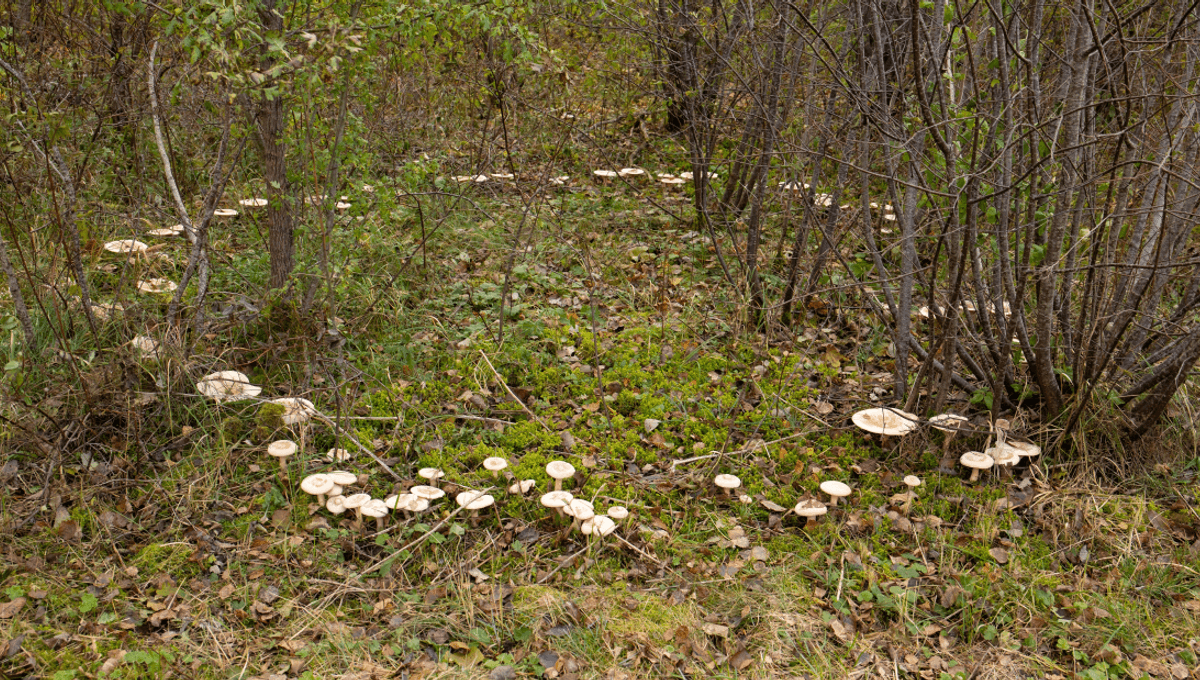
Have you ever been walking in the woods and stumbled across a perfect ring of mushrooms? These curious fungal displays are what’s known as a fairy ring, and their formation comes down to the strategic ways in which fungi’s mycelium networks spread out underground.
What are fairy rings?
We often think of mushrooms when we talk about fungi, but these fruiting bodies actually only make up a small and transient part of a fungus. Underground and out of sight, fungi develop through networks of small threads called hyphae that make up the mycelia. They sprout out from the original fungal spore and continue to grow evenly in all directions.
A single spore creates monokaryotic mycelia, which won’t be able to reproduce sexually until it joins with another mycelia to form a dikaryotic mycelium. When that happens, it’s mushroom-making time.
As it spreads, the mycelium will sprout fruiting bodies in the form of mushrooms, creating a small circle. The next year, they will pop up in a slightly larger circle, continuing to get bigger as the fungus gets older.
As mycologist Maurizio Zotti told National Geographic, fairy rings only develop when the soil the mycelium is consuming is homogenous, meaning it has a uniform composition throughout. As for why a ring shape, it’s possible that a circular formation may help the mycelium survive pathogen attacks.
How fairy rings alter the environment
When hyphae spread through the soil as a mycelium network grows, it breaks down organic matter which is crucial for healthy earth. Mycelium networks help recycle leaf litter and create food for a variety of small animals that live in the soil, and the same is true of fairy rings.
However, their influence isn’t always beneficial to other species. In a 2020 paper, it was found that a wave-like spread of fairy rings decreased plant, fungal, and bacterial diversity. In the Mediterranean grasslands studied, the effect of fairy rings was seen to cause profound changes in community composition, indicating that fairy ring-forming fungi may act as ecosystem engineers.
Why are they called fairy rings?
A ring of mushrooms is said to be formed by fairies dancing in a circle, according to English and Celtic folklore, but it’s not so happy-go-lucky as it sounds. If a human tries to join in the party by stepping inside the circle, the fairies will punish them by forcing them to dance until they faint. It’s not the first time dancing has become an agent of evil, just look at the peculiar dancing plagues that took place between the 11th and 17th centuries.
Meanwhile, in Germany, rings of mushrooms are thought to be where witches dance in the lead-up to Halloween. You might also spot witch’s butter while out searching for fairy rings, a vibrant yellow parasite that was thought to signify a witch had cursed your household.
Where you can find fairy circles
If the threat of being forced to dance ‘till you drop isn’t enough to put you off going in search of these beautiful fungal rings, then your best bet for tracking one down is heading to any woodland or grassy areas. Fungus loves moisture, so fall conditions after a spot of rain provide a good window for fairy rings sprouting up from the ground.
Happy dancing, and if you’ve not had enough of mycelium, perhaps you might like to check out their coffin options.
Source Link: Why Do Some Mushrooms Grow In Perfect Circles?